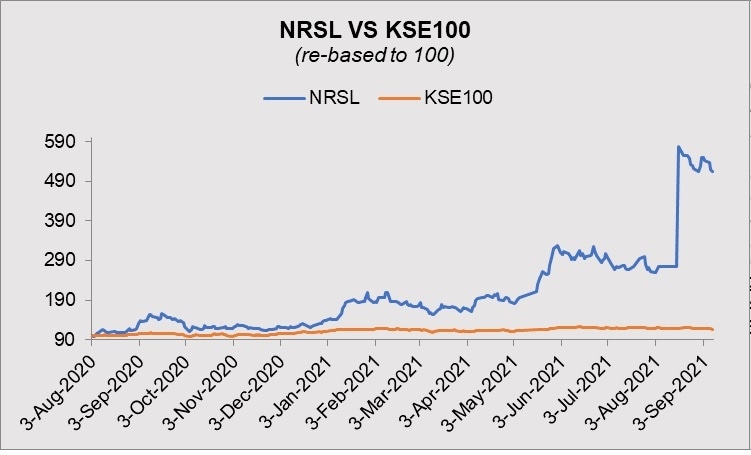Nimir Resins Limited (PSX: NRSL) was set up in 1964 as a private limited company under the Companies Act, 1913 (now, Companies Act, 2017). Several years later, in 1991 it was converted into a public limited company. The company is part of the larger Nimir Group of Companies. Nimir Industrial Chemicals is the ultimate parent company while Nimir Resins is a subsidiary of Nimir Management (Private) Limited.
Nimir Resins manufactures surface coating resins, polyesters for paint industry and optical brightener and textile auxiliaries for the textile industry. The company has five business lines: textile auxiliaries and binders, unsaturated polyester resins, coatings and emulsions, pulp and paper chemicals, adhesives and graphics and trading and exports.
Shareholding pattern

As at June 30, 2020, over 67 percent shares were held by the associated companies, undertakings and related parties. Of this, 51 percent shares were held by Nimir Management (Private) Limited. Over 26 percent shares were owned by the local general public, while the directors, CEO, their spouses and minor children owned close to 5 percent shares; within this, majority were held by Mr. Muhammad Yahya Khan, one of the directors on board. The remaining 2 percent shares are owned by the rest of the shareholder categories.
Historical operational performance
Nimir Resins has seen a fluctuating topline over the years, while profit margins have been relatively stable after FY16.
During FY17, the company saw the highest revenue growth, at over 50 percent. This was attributed to a volumetric gain, in addition to improved international prices. The company also saw a new management in the year, that focused on topline growth which is evident from revenue crossing Rs2 billion. But due to higher raw material purchases expense, production cost increased to nearly 89 percent of revenue, therefore reducing gross margin to 11 percent. On the other hand, the decline in administrative expense allowed operating margin to improve but was somewhat offset by the loss in other income. Thus, net margin remained more or less flat at 2.8 percent (FY16: 2.98 percent). The decline in administrative expense was a result of lower salaries and fees and subscription expense.

Revenue in FY18 stood at 34 percent, crossing Rs3 billion. This was again attributed to an improvement in volumes and international prices. But the currency devaluation in addition to “sharp increase in international prices of feedstock negatively impacted the cost of production”. This is reflected in production cost exceeding 90 percent of revenue, lowering gross margin to 9.2 percent for the year. With most other factors remaining unchanged as a share in revenue, the effect of lower gross margin also reflected in operating margin. Net margin, however, improved marginally to 2.9 percent due to a positive tax figure, compared to a tax expense of Rs37 million in the prior year.

Nimir Resins remained on its growth trajectory as revenue increased by over 36 percent in FY19, nearing Rs5 billion due to rise in volumes and prices. After increasing for two consecutive years, production cost reduced to below 90 percent of revenue, allowing gross margin to improve to over 10 percent. This also trickled down to the bottomline, as net margin also improved, albeit marginally, to a little over 3 percent. Other expenses of the company had reduced but was offset by the rise in finance expense that grew not only due to a rise in interest rates, but also due to an increase in business operations.

After rising for three consecutive years, topline declined by almost 8 percent in FY20. A major decline in revenue was prevented since the performance in the first three quarters was beyond the forecast. With timely procurement of raw materials and undertaking cost cutting allowed production cost to reduce further to over 88 percent of revenue. Thus, gross margin also improved to over 11 percent. This also reflected in the operating margin, but net margin fell below 3 percent, due to a rise in finance expense as a percentage of revenue, and a higher tax expense compared to the previous year.
Quarterly results and future outlook
The first quarter of FY21 saw revenue higher by over 11 percent year on year. As economic activities began after the easing of lock downs, volumes grew, evident by the growth in revenue. However, it did not translate into a higher gross margin due to expensive feedstock; gross margin was 9.5 percent, compared to 11.4 percent in 1QFY20. But due to the decline in finance expense as interest rates reduced, bottomline was better in 1QFY21 at 2.8 percent.
The second quarter also saw revenue higher year on year, by 7.7 percent as economic recovery gained traction. Production cost also reduced marginally, therefore profitability was better compared to 2QFY20. Latter was also supported by a decline in finance cost compared to the same period last year.

Third quarter also saw higher revenue by over 47 percent year on year due to improvement in volumes and prices. Production cost in 3QFY21 was the lowest among the three quarters of FY21, thus it not only saw better profit margins among the three quarters of FY21 but also that seen in the same period last year.
Given the diversified nature of the company’s products, it significantly benefits from economic recovery in various industries. But the uncertainty associated with the presence of the pandemic despite the roll out of the vaccination programs continues to pose a risk.



























Comments
Comments are closed.